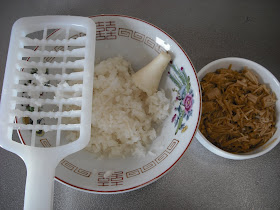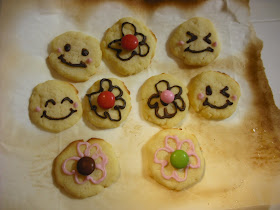I did it again! I have received an "award for excellence" in the "Recipe Contest", conducted by the Uonuma Kinoko and Sansai Promotion Association.
またやりました!魚沼きのこ・山菜振興協議会開催の「レシピコンテスト」で「優秀賞」を受賞しました。

Recipe title: Okonomiyaki with three types of mushroom
Ingredients for 4 servings
1. 200 g enoki
2. 6 small shiitake
3. 3 or 4 leaves cabbage
The total weight of 1 to 3 should be 400 g.
100 ml tenkasu (crunchy bits of deep-fried tempura batter)
100 ml sakura ebi (shrimp)
4 eggs
200 g low-gluten flour (hakurikiko)
1 tbsp baking powder
200 ml water
50 ml milk
1/2 tsp instant dashi
1 bag eryngii (substitute for thinly sliced pork)
Okonomiyaki sauce
Ao nori
Katsuobushi
Beni shoga
Mayonnaise
etc.
Directions:
1. Finely chop enoki, and put in a blender. Add water and milk, and process.
2. Finely chop shiitake. Remove dirt from stems, and finely chop them. (Don't just throw them away!)
3. Cut eryngii thinly lengthwise. 4 slices are required per okonomiyaki, 16 in total for 4 okonomiyaki.
4. Coarsely cut cabbage into 1-cm squares.
5. Sift 200 g flour, and put in a bowl. Add baking powder and instant dashi.
6. Add processed enoki to the bowl in 4. in 3 parts, mixing well each time.
7. Add shiitake, cabbage, eggs, tenkasu, and sakura ebi to the bowl, and mix well.
8. Put a small amount of oil in a 18-cm diameter frying pan, put on the stove, and put 1/4 of the contents of the bowl.
9. Place 4 slices of eryngii on top.
10. Cook with the lid on for 2 min.
11. Flip and cook with the lid on for 2 min.
12. Flip and cook without the lid for 2 min.
13. Flip again and cook without the lid for 2 min.
14. Transfer to a plate, and cut into appropriate size.
Repeat steps 8 to 14.
15. Let each diner place their favorite toppings (such as aonori, katsuobushi, beni shoga, okonomiyaki sauce, ketchup, and mayonnaise).
Cooking time: 30-40 min.
You can shorten the time by using two frying pans to make two at the same time.
Comments:
Inspired by "enoki koori", I processed enoki into pulp in a blender and used it instead of yama imo (lit. mountain potato). Partly due to the effect of the baking powder, the okonomiyaki turned out soft and delicious.
I used 18-cm frying pans so that the okonomiyaki could be made into a size of "16.4 cm in diameter and 1.9 cm in thickness", which was declared as an ideal size for okonomiyaki in a TV show. You can make decent okonomiyaki even if you don't have a hot plate!
If you think that eryngii alone is not enough, place some pork, too.
You may want to finely chop enoki instead of processing in a blender. When I made it for the first time, I didn't process enoki in a blender, but no one noticed that there was enoki in the okonomiyaki.
When you flip okonomiyaki, you may find it difficult to do so with a turner. If so, you may want to hold a plate in your right hand and the frying pan in your left, transfer the okonomiyaki by sliding it without flipping it, and then return the okonomiyaki to the frying pan quickly by flipping it this time.
Note: Chinese cabbage was sold cheap, so I used it instead of cabbage this time! Be flexible in cooking!
***
レシピタイトル 3種のきのこのお好み焼き
材料・分量 (4人前)
1.えのき 1袋(200g)
2.シイタケ 1パック(小6個)
3.キャベツ 3、4枚
1~3の総重量が400g
天カス 100 ml
桜えび 100 ml
卵 4個
薄力粉 200g
ベーキングパウダー 大さじ1
水 200 ml
牛乳 50 ml
出汁の素 小さじ1/2
エリンギ(薄切り豚肉の代わり) 1袋
お好み焼きソース
青のり
鰹節
紅しょうが
マヨネーズ
など
作り方 1.えのきを細かく刻み、ミキサーに入れる。水、牛乳を入れ、ミキサーをかける。
2.しいたけをみじん切りにする。軸も汚れを取り、みじん切りにする(捨てない!)。
3.エリンギは縦に薄く切る。お好み焼き4つにそれぞれ4枚、計16枚必要。
4.キャベツは1cm四方の荒みじん切りにする。
5.薄力粉200gをふるい、ボールに入れる。ベーキングパウダー、出汁の素を入れる。
6.4のボールに、ミキサーにかけたえのきを3回に分けて入れ、よく混ぜる。
7.しいたけ、キャベツ、たまご、天カス、桜えびをボールに入れ、よく混ぜる。
8.直径18センチ程度のフライパンに油を少量入れ、火にかけ、ボールの中身の1/4を入れる。
9.エリンギを4枚載せる。
10.蓋をして、2分焼く。
11.裏返して、蓋をして2分焼く。
12.裏返して、今度は蓋を外して、2分焼く。
13.再度裏返して、蓋をせずに、2分焼く。
14.皿に移し、適当な大きさに切る。
8~14を繰り返す。
15.食べる人が各人、好きなもの(青海苔、鰹節、紅しょうが、お好み焼きソース、ケチャップ、マヨネーズなど)を載せる。
料理時間 30~40分。フライパンを2つ用意して、同時に焼くと、時間を短縮できる。
コメント 「えのき氷」をヒントに、山芋の代わりに、えのきをミキサーにかけて、ドロドロにして、使いました。ベーキングパウダーの効果もあり、柔らかく、美味しくできました。
お好み焼きの大きさは、某テレビ番組が理想とする「直径16.4センチ、厚み1.9センチ」になるよう、18センチのフライパンを使用しました。ホットプレートがなくても、お好み焼きはできます!
エリンギだけでは物足りない場合は、豚肉も載せてください。
えのきはミキサーにかけずに、細かく刻むだけでもいいです。初めて作った時は、ミキサーにかけなかったのですが、誰もえのきの存在に気付きませんでした。
お好み焼きを裏返す時、フライ返しではうまく行かないことが多いので、お皿を右手に、フライパンを左手に持ち、お好み焼きを、裏返さずに、滑らすように、お皿に移し、次にお皿からフライパンにすばやく、今度は裏返るように戻すと、うまく裏返せます。
注: 今回は、白菜が安く売っていたので、キャベツの代わりに使いました!料理は臨機応変に!
Other photos:
他の写真:


























































